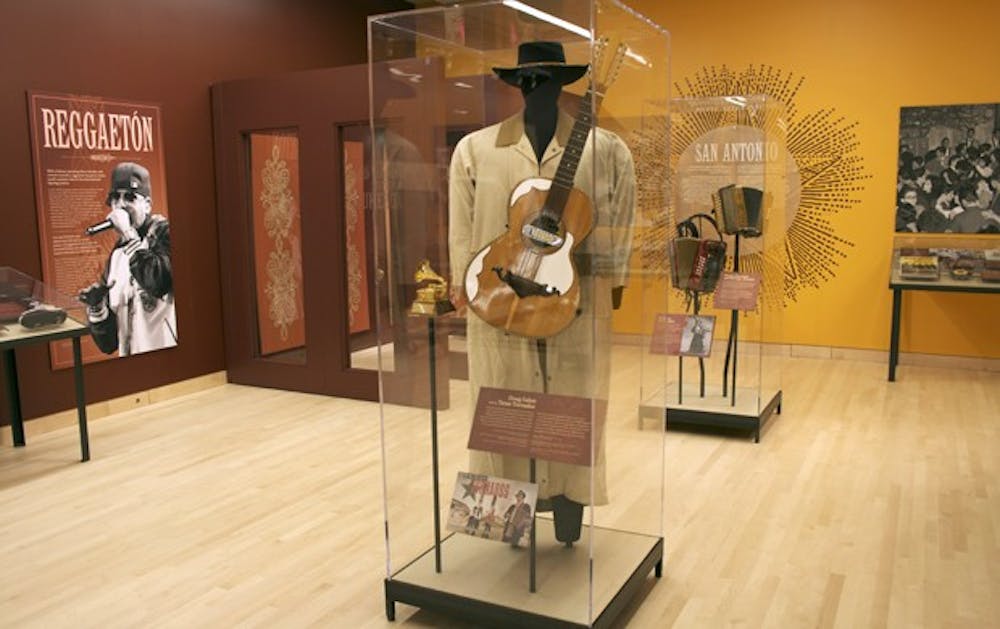When you first enter the “American Sabor: Latinos in U.S. Popular Music” exhibition at Phoenix's Musical Instrument Museum, you'll hear artists ranging from Celia Cruz to Selena, Ritchie Valens to Daddy Yankee. On the vibrant walls you'll see old concert posters and a flier that promoted an array of rock bands playing in a 1965 massive-headline show that cost only $1.75 at the Shrine Auditorium in Los Angeles.
This traveling exhibition, which opened in November and ends May 18, explores the historical influence Latino artists have had on music in the United States.
“It’s a big deal,” says exhibition visitor Olga Aros, while looking at a picture of Sam the Sham and the Pharaohs. “There is so little information about Latinos [in the music industry]."
The band pictured in the photo she's looking at wrote the famous song “Wooly Bully” in 1965, and to Aros’ surprise, lead singer Domingo Samudio is Mexican-American.
“Who would have [thought] that [Sam the Sham] was from Latino descent?” Aros says. “‘Wooly Bully’ was such a big song when I was a kid.”
The exhibition is separated by the major cities of the United States — New York, San Antonio, San Francisco and Los Angeles. Each section highlights major artists that have reshaped music.
New York
Hung in a glass case in the far-left corner of the room is a large black dress with silver studs decorating the neck of the outfit. The dress once belonged to the late Celia Cruz, the “queen of Salsa,” who left Cuba while Fidel Castro was rising to power in the 1960s.
New York is also where hip hop originated in the '70s, with DJs scratching records while break dancers spinned and rappers emceed over the DJ’s beat. It was in 1975 that DJ Charlie Chase first appeared on the NYC hip-hop scene. Chase is the Puerto Rican-American considered a pioneer for bringing Latinos into the genre, and eventually creating reggaeton.
Against the wall is a large portrait of Daddy Yankee, a Puerto Rican who helped bring reggaeton to mainstream music. It was his hit-song “Gasolina” that not only earned him success, but helped all Latinos in the genre find success.
San Antonio
Against the wall near the San Antonio section is a flier promoting the last major concert Selena did on Feb. 26, 1995, at the Houston Astrodome.
For seven years in a row, starting in 1988, Selena won best female vocalist of the year at the Tejano Music Awards in San Antonio. Even though her first language was English, her most successful songs were in Spanish.
Los Angeles and San Francisco
While some Latino artists use Latin music as inspiration to write their own music, other artists happen be Latinos who love American music. For example, Ritchie Valens, a Mexican-American born near Los Angeles.
In the middle of the exhibition room is an encased photograph from 1958 of Valens slouching on a steel chair. He wears white slacks and a black sweater while jamming on his guitar and looking directly at the camera.
Valens’ musical career lasted less than a year. His most successful hit, however, was “La Bamba,” a traditional Mexican folk song that originated in Veracruz, Mexico. The song is in Spanish even though Valens hardly spoke the language.
Valens was also the first Latino rock star, but in order to gain success and the attention of the Anglo rock fans, Bob Keane, who helped Valens start his professional musical career, shortened his name from Richard Valenzuela.
Eventually, his legacy would inspire other Latino rock artists. But when you move to the San Francisco section of the exhibit, you’ll see a large portrait of Santana dressed in a black vest and pants, with an uncombed Afro, his fingers pressing on electric-guitar strings, performing at Woodstock in front of thousands of people.
Unlike Valens, Santana immigrated to San Francisco from Mexico. It was in 1969 that he gave an unforgettable performance and wooed the Woodstock crowd. There’s a brown booth where you can sit and watch part of the performance on a TV attached to the wall, emerging yourself even more in the rich history of Latino music.
As part of the exhibition, ASU film professor Paul Espinosa is hosting a series of films relating to Latinos' musical contributions. The next showing is “The Salsa Revolution" at 2 p.m. on May 8. The museum event is free with regular admission.
Contact the reporter at uriel.garcia@asu.edu





